Research Report Series: Anabolic Steroid Abuse
Download PDF Version What is PDF?
Source: NIDA Research Report Series: Anabolic Steroid Abuse, NIH Publication Number 00-3721, 1991, Reprinted 1994, 1996. Revised April, 2000
Public Domain
Table of Contents (TOC)
From the DirectorChapter 1: What are anabolic steroids?
Chapter 2: What are steroidal supplements?
Chapter 3: What is the scope of steroid abuse in the United States?
Chapter 4: Why do people use anabolic steroids?
Chapter 5: How are anabolic steroids used?
Chapter 6: What are the health consequences of steroid abuse?
Chapter 7: What effects do anabolic steroids have on behavior?
Chapter 8: Are anabolic steroids addictive?
Chapter 9: What can be done to prevent steroid abuse?
Chapter 10: What treatments are effective for anabolic steroid abuse?
Glossary
References
Since the 1950s, some athletes have been taking anabolic steroids to build muscle and boost their athletic performance. Increasingly, other segments of the population also have been taking these compounds. The Monitoring the Future study, which is an annual survey of drug abuse among adolescents across the country, showed a significant increase from 1998 to 1999 in steroid abuse among middle school students. During the same year, the percentage of 12th-graders who believed that taking these drugs causes "great risk" to health, declined from 68 percent to 62 percent.
Studies show that, over time, anabolic steroids can indeed take a heavy toll on a person’s health. The abuse of oral or injectable steroids is associated with higher risks for heart attacks and strokes, and the abuse of most oral steroids is associated with increased risk for liver problems. Steroid abusers who share needles or use nonsterile techniques when they inject steroids are at risk for contracting dangerous infections, such as HIV/AIDS, hepatitis B and C, and bacterial endocarditis.
 Anabolic steroid abuse can also cause undesirable body changes. These
include breast development and genital shrinking in men, masculinization
of the body in women, and acne and hair loss in both sexes.
Anabolic steroid abuse can also cause undesirable body changes. These
include breast development and genital shrinking in men, masculinization
of the body in women, and acne and hair loss in both sexes.
These and other effects of steroid abuse are discussed in this Research Report, which is one of a series of reports on drugs of abuse. NIDA produces this series to increase understanding of drug abuse and addiction and the health effects associated with taking drugs.
We hope that this compilation of scientific information on anabolic steroids will help the public recognize the risks of steroid abuse.
Alan I. Leshner, Ph.D.
Director
National Institute on Drug Abuse
"Anabolic steroids" is the familiar name for synthetic substances related to the male sex hormones (androgens). They promote the growth of skeletal muscle (anabolic effects) and the development of male sexual characteristics (androgenic effects), and also have some other effects. The term "anabolic steroids" will be used through-out this report because of its familiarity, although the proper term for these compounds is "anabolic-androgenic" steroids.
Anabolic steroids were developed in the late 1930s primarily to treat hypogonadism, a condition in which the testes do not produce sufficient testosterone for normal growth, development, and sexual functioning. The primary medical uses of these compounds are to treat delayed puberty, some types of impotence, and wasting of the body caused by HIV infection or other diseases.
During the 1930s, scientists discovered that anabolic steroids could facilitate the growth of skeletal muscle in laboratory animals, which led to use of the compounds first by bodybuilders and weightlifters and then by athletes in other sports. Steroid abuse has become so widespread in athletics that it affects the outcome of sports contests.
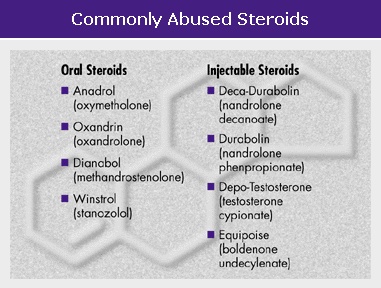
More than 100 different anabolic steroids have been developed, but they require a prescription to be used legally in the United States. Most steroids that are used illegally are smuggled in from other countries, illegally diverted from U.S. pharmacies, or synthesized in clandestine laboratories.
In the United States, supplements such as dehydroepian-drosterone (DHEA) and androstenedione (street name Andro) can be purchased legally without a prescription through many commercial sources including health food stores. They are often referred to as dietary supplements, although they are not food products. They are often taken because the user believes they have anabolic effects.
Steroidal supplements can be converted into testosterone (an important male sex hormone) or a similar compound in the body. Whether such conversion produces sufficient quantities of testosterone to promote muscle growth or whether the supplements themselves promote muscle growth is unknown. Little is known about the side effects of steroidal supplements, but if large quantities of these compounds substantially increase testosterone levels in the body, they also are likely to produce the same side effects as anabolic steroids.
Recent evidence suggests that steroid abuse among adolescents is on the rise. The 1999 Monitoring the Future study, a NIDA-funded survey of drug abuse among adolescents in middle and high schools across the United States, estimated that 2.7 percent of 8th- and 10th-graders and 2.9 percent of 12th-graders had taken anabolic steroids at least once in their lives. For 10th-graders, that is a significant increase from 1998, when 2.0 percent of 10th-graders said they had taken anabolic steroids at least once. For all three grades, the 1999 levels represent a significant increase from 1991, the first year that data on steroid abuse were collected from the younger students. In that year, 1.9 percent of 8th-graders, 1.8 percent of 10th-graders, and 2.1 percent of 12th-graders reported that they had taken anabolic steroids at least once.
From 1998 to 1999, the Monitoring the Future Survey reported an increase in lifetime use of steroids among 10th-graders and a decrease in perceived risk of harm among seniors.
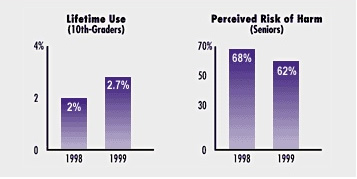
Few data exist on the extent of steroid abuse by adults. It has been estimated that hundreds of thousands of people aged 18 and older abuse anabolic steroids at least once a year.
Among both adolescents and adults, steroid abuse is higher among males than females. However, steroid abuse is growing most rapidly among young women.
One of the main reasons people give for abusing steroids is to improve their performance in sports. Among competitive bodybuilders, steroid abuse has been estimated to be very high. Among other athletes, the incidence of abuse probably varies depending on the specific sport.
Another reason people give for taking steroids is to increase their muscle size and/or reduce their body fat. This group includes some people who have a behavioral syndrome (muscle dysmorphia) in which a person has a distorted image of his or her body. Men with this condition think that they look small and weak, even if they are large and muscular. Similarly, women with the syndrome think that they look fat and flabby, even though they are actually lean and muscular.
Some people who abuse steroids to boost muscle size have experienced physical or sexual abuse. They are trying to increase their muscle size to protect themselves. In one series of interviews with male weightlifters, 25 percent who abused steroids reported memories of childhood physical or sexual abuse, compared with none who did not abuse steroids. In a study of women weightlifters, twice as many of those who had been raped reported using anabolic steroids and/or another purported muscle-building drug, compared to those who had not been raped. Moreover, almost all of those who had been raped reported that they markedly increased their bodybuilding activities after the attack. They believed that being bigger and stronger would discourage further attacks because men would find them either intimidating or unattractive.
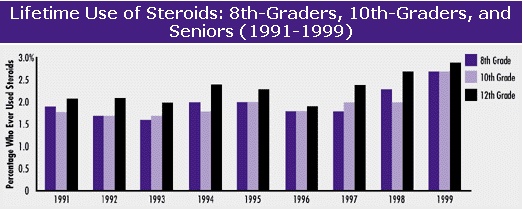
Finally, some adolescents abuse steroids as part of a pattern of high-risk behaviors. These adolescents also take risks such as drinking and driving, carrying a gun, not wearing a helmet on a motorcycle, and abusing other illicit drugs.
While conditions such as muscle dysmorphia, a history of physical or sexual abuse, or a history of engaging in high-risk behaviors may increase the risk of initiating or continuing steroid abuse, researchers agree that most steroid abusers are psychologically normal when they start abusing the drugs.
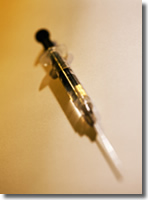 Some anabolic steroids
are taken orally, others are injected intramuscularly,
and still others are provided in gels or creams that are
rubbed on the skin. Doses taken by abusers can be 10 to
100 times higher than the doses used for medical conditions.
Some anabolic steroids
are taken orally, others are injected intramuscularly,
and still others are provided in gels or creams that are
rubbed on the skin. Doses taken by abusers can be 10 to
100 times higher than the doses used for medical conditions.
Steroid abusers typically "stack" the drugs, meaning that they take two or more different anabolic steroids, mixing oral and/or injectable types and sometimes even including compounds that are designed for veterinary use. Abusers think that the different steroids interact to produce an effect on muscle size that is greater than the effects of each drug individually, a theory that has not been tested scientifically.
Often, steroid abusers also "pyramid" their doses in cycles of 6 to 12 weeks. At the beginning of a cycle, the person starts with low doses of the drugs being stacked and then slowly increases the doses. In the second half of the cycle, the doses are slowly decreased to zero. This is sometimes followed by a second cycle in which the person continues to train but without drugs. Abusers believe that pyramiding allows the body time to adjust to the high doses and the drug-free cycle allows the body’s hormonal system time to recuperate. As with stacking, the perceived benefits of pyramiding and cycling have not been substantiated scientifically.
Possible Health Consequences of Anabolic Steroid Abuse |

|
Anabolic steroid abuse has been associated with a wide range of adverse side effects ranging from some that are physically unattractive, such as acne and breast development in men, to others that are life threatening, such as heart attacks and liver cancer. Most are reversible if the abuser stops taking the drugs, but some are permanent.
Most data on the long-term effects of anabolic steroids on humans come from case reports rather than formal epidemiological studies. From the case reports, the incidence of life-threatening effects appears to be low, but serious adverse effects may be under-recognized or under-reported. Data from animal studies seem to support this possibility. One study found that exposing male mice for one-fifth of their lifespan to steroid doses comparable to those taken by human athletes caused a high percentage of premature deaths.
Hormonal system
Steroid abuse disrupts the normal production of hormones in the body, causing both reversible and irreversible changes. Changes that can be reversed include reduced sperm production and shrinking of the testicles (testicular atrophy). Irreversible changes include male-pattern baldness and breast development (gynecomastia). In one study of male bodybuilders, more than half had testicular atrophy, and more than half had gynecomastia. Gynecomastia is thought to occur due to the disruption of normal hormone balance. In the female body, anabolic steroids cause masculinization. Breast size and body fat decrease, the skin becomes coarse, the clitoris enlarges, and the voice deepens. Women may experience excessive growth of body hair but lose scalp hair. With continued administration of steroids, some of these effects are irreversible.
Musculoskeletal system
Rising levels of testosterone and other sex hormones normally trigger the growth spurt that occurs during puberty and adolescence. Subsequently, when these hormones reach certain levels, they signal the bones to stop growing, locking a person into his or her maximum height.
When a child or adolescent takes anabolic steroids, the resulting artificially high sex hormone levels can signal the bones to stop growing sooner than they normally would have done.
Cardiovascular system
Steroid abuse has been associated with cardiovascular diseases (CVD), including heart attacks and strokes, even in athletes younger than 30. Steroids contribute to the development of CVD, partly by changing the levels of lipoproteins that carry cholesterol in the blood. Steroids, particularly the oral types, increase the level of low-density lipoprotein (LDL) and decrease the level of high-density lipoprotein (HDL). High LDL and low HDL levels increase the risk of atherosclerosis, a condition in which fatty substances are deposited inside arteries and disrupt blood flow. If blood is prevented from reaching the heart, the result can be a heart attack. If blood is prevented from reaching the brain, the result can be a stroke.
Steroids also increase the risk that blood clots will form in blood vessels, potentially disrupting blood flow and damaging the heart muscle so that it does not pump blood effectively.
Liver
Steroid abuse has been associated with liver tumors and a rare condition called peliosis hepatis, in which blood-filled cysts form in the liver. Both the tumors and the cysts sometimes rupture, causing internal bleeding.
Skin
Steroid abuse can cause acne, cysts, and oily hair and skin.
Infection
Many abusers who inject anabolic steroids use nonsterile injection techniques or share contaminated needles with other abusers. In addition, some steroid preparations are manufactured illegally under non-sterile conditions. These factors put abusers at risk for acquiring life-threatening viral infections, such as HIV and hepatitis B and C. Abusers also can develop infective endocarditis, a bacterial illness that causes a potentially fatal inflammation of the inner lining of the heart. Bacterial infections also can cause pain and abscess formation at injection sites.
Case reports and small studies indicate that anabolic steroids, particularly in high doses, increase irritability and aggression. Some steroid abusers report that they have committed aggressive acts, such as physical fighting, committing armed robbery, or using force to obtain something. Some abusers also report that they have committed property crimes, such as stealing from a store, damaging or destroying others’ property, or breaking into a house or a building. Abusers who have committed aggressive acts or property crimes generally report that they engage in these behaviors more often when they take steroids than when they are drug-free.
Some researchers have suggested that steroid abusers may commit aggressive acts and property crimes not because of steroids’ direct effects on the brain but because the abusers have been affected by extensive media attention to the link between steroids and aggression. According to this theory, the abusers are using this possible link as an excuse to commit aggressive acts and property crimes.
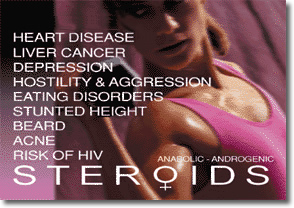
One way to distinguish between these two possibilities is to administer either high steroid doses or placebo for days or weeks to human volunteers and then ask the people to report on their behavioral symptoms. To date, four such studies have been conducted. In three, high steroid doses did produce greater feelings of irritability and aggression than did placebo; but in one study, the drugs did not have that effect. One possible explanation, according to researchers, is that some but not all anabolic steroids increase irritability and aggression.
Anabolic steroids have been reported also to cause other behavioral effects, including euphoria, increased energy, sexual arousal, mood swings, distractibility, forgetfulness, and confusion. In the studies in which researchers administered high steroid doses to volunteers, a minority of the volunteers developed behavioral symptoms that were so extreme as to disrupt their ability to function in their jobs or in society. In a few cases, the volunteers’ behavior presented a threat to themselves and others.
In summary, the extent to which steroid abuse contributes to violence and behavioral disorders is unknown. As with the health complications of steroid abuse, the prevalence of extreme cases of violence and behavioral disorders seems to be low, but it may be underreported or underrecognized.
An undetermined percentage of steroid abusers become addicted to the drugs, as evidenced by their continuing to take steroids in spite of physical problems, negative effects on social relations, or nervousness and irritability. Also, they spend large amounts of time and money obtaining the drugs and experience withdrawal symptoms such as mood swings, fatigue, restlessness, loss of appetite, insomnia, reduced sex drive, and the desire to take more steroids. The most dangerous of the withdrawal symptoms is depression, because it sometimes leads to suicide attempts. Untreated, some depressive symptoms associated with anabolic steroid withdrawal have been known to persist for a year or more after the abuser stops taking the drugs.
Early attempts to prevent steroid abuse concentrated on drug testing and on educating students about the drugs’ adverse effects. A few school districts test for abuse of illicit drugs, including steroids, and studies are currently under way to determine whether such testing reduces drug abuse.
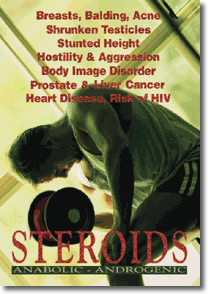
Research on steroid educational programs has shown that simply teaching students about steroids’ adverse effects does not convince adolescents that they personally can be adversely affected. Nor does such instruction discourage young people from taking steroids in the future. Presenting both the risks and benefits of anabolic steroid use is more effective in convincing adolescents about steroids’ negative effects, apparently because the students find a balanced approach more credible and less biased, according to the researchers. However, the balanced approach still does not discourage adolescents from abusing steroids.
A more sophisticated approach has shown promise for preventing steroid abuse among players on high school sports teams. In the ATLAS program, developed for male football players, coaches and team leaders discuss the potential effects of anabolic steroids and other illicit drugs on immediate sports performance, and they teach how to refuse offers of drugs. They also discuss how strength training and proper nutrition can help adolescents build their bodies without the use of steroids. Later, special trainers teach the players proper weightlifting techniques. An ongoing series of studies has shown that this multicomponent, team-centered approach reduces new steroid abuse by 50 percent. A program designed for adolescent girls on sports teams, patterned after the program designed for boys, is currently being tested.
Few studies of treatments for anabolic steroid abuse have been conducted. Current knowledge is based largely on the experiences of a small number of physicians who have worked with patients undergoing steroid withdrawal. The physicians have found that supportive therapy is sufficient in some cases. Patients are educated about what they may experience during withdrawal and are evaluated for suicidal thoughts.
If symptoms are severe or prolonged, medications or hospitalization may be needed.
Some medications that have been used for treating steroid withdrawal restore the hormonal system after its disruption by steroid abuse. Other medications target specific withdrawal symptoms for example, antidepressants to treat depression, and analgesics for head-aches and muscle and joint pains.
Some patients require assistance beyond simple treatment of withdrawal symptoms and are treated with behavioral therapies.
Addiction: A chronic, relapsing disease, characterized by compulsive drug-seeking and use and by neurochemical and molecular changes in the brain.
Anabolic effects: Drug-induced growth or thickening of the body’s nonreproductive tract tissues - including skeletal muscle, bones, the larynx, and vocal cords - and decrease in body fat.
Analgesics: A group of medications that reduce pain.
Androgenic effects: A drug’s effects upon the growth of the male reproductive tract and the development of male secondary sexual characteristics.
Antidepressants: A group of drugs used in treating depressive disorders.
Cardiovascular system: The heart and blood vessels.
Hormone: A chemical substance formed in glands in the body and carried in the blood to organs and tissues, where it influences function, structure, and behavior.
Musculoskeletal system: The muscles, bones, tendons, and ligaments.
Placebo: An inactive substance, used in experiments to distinguish between actual drug effects and effects that are expected by the volunteers in the experiments.
Sex hormones: Hormones that are found in higher quantities in one sex than in the other. Male sex hormones are the androgens, which include testosterone; and the female sex hormones are the estrogens and progesterone.
Withdrawal: Symptoms that occur after chronic use of a drug is reduced or stopped.
Bahrke, M.S., Yesalis, C.E., and Wright, J.E. Psychological and behavioral effects of endogenous testosterone and anabolic-androgenic steroids: an update. Sports Medicine 22(6): 367-390, 1996.
Blue, J.G., and Lombardo, J.A. Steroids and steroid-like compounds. Clinics in Sports Medicine 18(3): 667-689, 1999.
Bronson, F.H., and Matherne, C.M. Exposure to anabolic-androgenic steroids shortens life span of male mice. Medicine and Science in Sports and Exercise 29(5): 615-619, 1997.
Brower, K.J. Withdrawal from anabolic steroids. Current Therapy in Endocrinology and Metabolism 6: 338-343, 1997.
Elliot, D., and Goldberg, L. Intervention and prevention of steroid use in adolescents. The American Journal of Sports Medicine 24(6): S46-S47, 1996.
Goldberg, L., et al. Anabolic steroid education and adolescents: Do scare tactics work? Pediatrics 87(3): 283-286, 1991.
Goldberg, L., et al. Effects of a multidimensional anabolic steroid prevention intervention: The Adolescents Training and Learning to Avoid Steroids (ATLAS) Program. Journal of the American Medical Association 276(19): 1555-1562, 1996.
Goldberg, L., et al. The ATLAS program: Preventing drug use and promoting health behaviors. Archives of Pediatrics and Adolescent Medicine 154: 332-338, 2000.
Gruber, A.J., and Pope, H.G., Jr. Compulsive weight lifting and anabolic drug abuse among women rape victims. Comprehensive Psychiatry 40(4): 273-277, 1999.
Gruber, A.J., and Pope, H.G., Jr. Psychiatric and medical effects of anabolic-androgenic steroid use in women. Psychotherapy and Psychosomatics 69: 19-26, 2000.
Hoberman, J.M., and Yesalis, C.E. The history of synthetic testosterone. Scientific American 272(2): 76-81, 1995.
Leder, B.Z., et al. Oral androstenedione administration and serum testosterone concentrations in young men. Journal of the American Medical Association 283(6): 779-782, 2000.
The Medical Letter on Drugs and Therapeutics. Creatine and androstenedione-two "dietary supplements." 40(1039): 105-106, 1998.
Middleman, A.B, et al. High-risk behaviors among high school students in Massachusetts who use anabolic steroids. Pediatrics 96(2): 268-272, 1995.
Pope, H.G., Jr., Kouri, E.M., and Hudson, M.D. Effects of supraphysiologic doses of testosterone on mood and aggression in normal men. Archives of General Psychiatry 57(2): 133-140, 2000.
Porcerelli, J.H., and Sandler, B.A. Anabolic-androgenic steroid abuse and psychopathology. Psychiatric Clinics of North America 21(4): 829-833, 1998.
Porcerelli, J.H., and Sandler, B.A. Narcissism and empathy in steroid users. American Journal of Psychiatry 152(11): 1672-1674, 1995.
Rich, J.D., Dickinson, B.P., Flanigan, T.P., and Valone, S.E. Abscess related to anabolic-androgenic steroid injection. Medicine and Science in Sports and Exercise 31(2): 207-209, 1999.
Su, T.-P., et al. Neuropsychiatric effects of anabolic steroids in male normal volunteers. Journal of the American Medical Association 269(21): 2760-2764, 1993.
Sullivan, M.L., Martinez, C.M., Gennis, P., and Gallagher, E.J. The cardiac toxicity of anabolic steroids. Progress in Cardiovascular Diseases 41(1): 1-15, 1998.
Yesalis, C.E. Anabolic Steroids in Sports and Exercise, 2nd edition. Champaign, IL: Human Kinetics.In press.
Yesalis, C.E. Androstenedione. Sport Dietary Supplements Update, 2000, E-SportMed.com.
Yesalis, C.E. Trends in anabolic-androgenic steroid use among adolescents. Archives of Pediatrics and Adolescent Medicine 151: 1197-1206, 1997.
Yesalis, C.E., Kennedy, N.J., Kopstein, A.N., and Bahrke, M.S. Anabolic-androgenic steroid use in the United States. Journal of the American Medical Association 270(10): 1217-1221, 1993.
Zorpette, G. Andro angst. Scientific American 279(6): 22-26, 1998.


